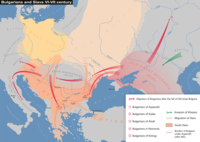Alzeco as Alciocus
Researchers have, in the past, claimed one identification of both historical figures. [6] They have suggested that Alzeco might be identified with the Bulgar leader Alciocus of the Fredegar chronicle. This notion, however, must surmount a significant chronological contradiction, and it is possible that this was a title rather than a personal name. [7] [8] [9]
In any case, it seems more likely that the "Vulgares" that settled in the Molise are more likely to refer to the men of Alciocus, as most of the tombs excavated at Campochiaro can be dated around the middle of the 7th century, with some being certainly earlier or later. This would indicate a settlement in the area some time before the reign of Romuald as Duke in Benevento and Grimoald as king in Pavia. Furthermore, this is supported by the fact that the Longobards had no control of the Ravennate lands until the second half of the 8th century, meaning that Grimoald would have been unable to settle them in this area without Byzantine approval, which would be strange as Costans II was in the midst of a disastrous Italian campaign against the Southern Longobards.
It is very probable that Paul the Deacon confused the settlement of Alzeco/Alciocus in the Molise after his flight from Dagobert I with another event about 50 years later, specifically the settlement of one of Kubrat's/Kurt's unnamed sons around Ravenna, most likely as a form of protection against the Longobards for the nominally Byzantine Exarchate. The name of the leader of this group is completely unknown, although the settlement may have been known thanks to Byzantine records in the Exarchate. [10]

The Lombards or Longobards were a Germanic people who conquered most of the Italian Peninsula between 568 and 774.
The 660s decade ran from January 1, 660, to December 31, 669.

The Bulgars were Turkic semi-nomadic warrior tribes that flourished in the Pontic–Caspian steppe and the Volga region between the 5th and 7th centuries. They became known as nomadic equestrians in the Volga-Ural region, but some researchers believe that their ethnic roots can be traced to Central Asia.
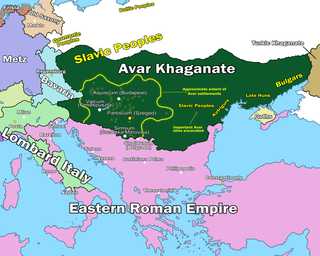
The Pannonian Avars were an alliance of several groups of Eurasian nomads of various origins. The peoples were also known as the Obri in chronicles of Rus, the Abaroi or Varchonitai, or Pseudo-Avars in Byzantine sources, and the Apar to the Göktürks. They established the Avar Khaganate, which spanned the Pannonian Basin and considerable areas of Central and Eastern Europe from the late 6th to the early 9th century.

Volga Bulgaria or Volga–Kama Bulgaria was a historical Bulgar state that existed between the 9th and 13th centuries around the confluence of the Volga and Kama River, in what is now European Russia. Volga Bulgaria was a multi-ethnic state with large numbers of Bulgars, Finno-Ugrians, Varangians, and East Slavs. Its strategic position allowed it to create a local trade monopoly with Norse, Cumans, and Pannonian Avars.

Hungarian prehistory spans the period of history of the Hungarian people, or Magyars, which started with the separation of the Hungarian language from other Finno-Ugric or Ugric languages around 800 BC, and ended with the Hungarian conquest of the Carpathian Basin around 895 AD. Based on the earliest records of the Magyars in Byzantine, Western European, and Hungarian chronicles, scholars considered them for centuries to have been the descendants of the ancient Scythians and Huns. This historiographical tradition disappeared from mainstream history after the realization of similarities between the Hungarian language and the Uralic languages in the late 18th century. Thereafter, linguistics became the principal source of the study of the Hungarians' ethnogenesis. In addition, chronicles written between the 9th and 15th centuries, the results of archaeological research and folklore analogies provide information on the Magyars' early history. After the 2000s, archaeological research aimed at exploring the early history of the Hungarians resumed in the Ural Mountains region. Today, these efforts are regularly supplemented with archaeogenetic studies. In addition to linguistics, archaeology, and archaeogenetics, the re-evaluation of well-known written sources has also begun. Together, these fields of study may provide new information regarding the origins of the Hungarian people.

The First Bulgarian Empire was a medieval state that existed in Southeastern Europe between the 7th and 11th centuries AD. It was founded in 680–681 after part of the Bulgars, led by Asparuh, moved south to the northeastern Balkans. There they secured Byzantine recognition of their right to settle south of the Danube by defeating – possibly with the help of local South Slavic tribes – the Byzantine army led by Constantine IV. During the 9th and 10th century, Bulgaria at the height of its power spread from the Danube Bend to the Black Sea and from the Dnieper River to the Adriatic Sea and became an important power in the region competing with the Byzantine Empire.

Mirabello Sannitico is a small town in the province of Campobasso, Molise, southern Italy. The population is about 2,100 inhabitants. It has an agrarian-based culture and history, dating back to at least the 12th century. Nearby towns include Campobasso to the northwest and Vinchiaturo to the southwest. The Tappino River flows on either side of the town on the north and south.
The Turkic migrations were the spread of Turkic tribes and Turkic languages across Eurasia between the 4th and 11th centuries. In the 6th century, the Göktürks overthrew the Rouran Khaganate in what is now Mongolia and expanded in all directions, spreading Turkic culture throughout the Eurasian steppes. Although Göktürk empires came to an end in the 8th century, they were succeeded by numerous Turkic empires such as the Uyghur Khaganate, Kara-Khanid Khanate, Khazars, and the Cumans. Some Turks eventually settled down into sedentary societies such as the Qocho and Ganzhou Uyghurs. The Seljuq dynasty settled in Anatolia starting in the 11th century, resulting in permanent Turkic settlement and presence there. Modern nations with large Turkic populations include Kyrgyzstan, Turkmenistan, Turkey, Azerbaijan, Uzbekistan and Kazakhstan, and Turkic populations also exist within other nations, such as Chuvashia, Bashkortostan, Tatarstan and the Sakha Republic of Siberia in Russia, Northern Cyprus, the Crimean Tatars, the Kazakhs in Mongolia, the Uyghurs in China, and the Azeris in Iran.
The Croats trace their origins to a southwards migration of some of the Early Slavs in the 6th- and 7th-centuries CE, a tradition supported by anthropological, genetic, and ethnological studies. However, the archaeological and other historic evidence on the migration of the Slavic settlers, on the character of the native population in the present-day territory of Croatia, and on their mutual relationships suggests diverse historical and cultural influences.
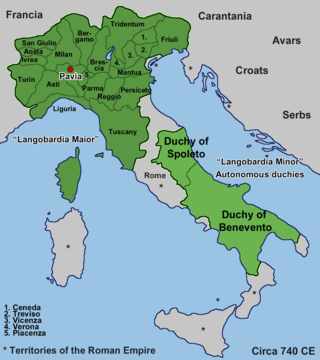
The Kingdom of the Lombards, also known as the Lombard Kingdom and later as the Kingdom of all Italy, was an early medieval state established by the Lombards, a Germanic people, on the Italian Peninsula in the latter part of the 6th century. The king was traditionally elected by the very highest-ranking aristocrats, the dukes, as several attempts to establish a hereditary dynasty failed. The kingdom was subdivided into a varying number of duchies, ruled by semi-autonomous dukes, which were in turn subdivided into gastaldates at the municipal level. The capital of the kingdom and the center of its political life was Pavia in the modern northern Italian region of Lombardy.

The Duchy of Friuli was a Lombard duchy in present-day Friuli, the first to be established after the conquest of the Italian peninsula in 568. It was one of the largest domains in Langobardia Major and an important buffer between the Lombard kingdom and the Slavs, Avars, and the Byzantine Empire. The original chief city in the province was Roman Aquileia, but the Lombard capital of Friuli was Forum Julii, modern Cividale.
Eugenius Vulgarius was an Italian priest and poet.

Hungarians, also known as Magyars, are a Central European nation and an ethnic group native to Hungary and historical Hungarian lands who share a common culture, history, ancestry, and language. The Hungarian language belongs to the Uralic language family, alongside, most notably Finnish and Estonian.

The Bulgarians in Italy are one of the sizable communities of the Bulgarian diaspora in Western Europe. There are about 120,000 Bulgarians in Italy according to the Bulgarian government. There are Bulgarian Orthodox parishes in Rome and Milan. Major centres of Bulgarian migration are Milan, Bologna, Florence and Torino.
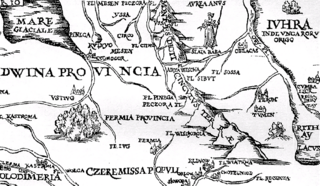
Hungary, the name in English for the European country, is an exonym derived from the Medieval Latin Hungaria. The Latin name itself derives from the ethnonyms (H)ungarī, Ungrī, and Ugrī for the steppe people that conquered the land today known as Hungary in the 9th and 10th centuries. Medieval authors denominated the Hungarians as Hungaria, but the Hungarians even contemporarily denominate themselves Magyars and their homeland Magyarország.

The Hungarian conquest of the Carpathian Basin, also known as the Hungarian conquest or the Hungarian land-taking, was a series of historical events ending with the settlement of the Hungarians in Central Europe in the late 9th and early 10th century. Before the arrival of the Hungarians, three early medieval powers, the First Bulgarian Empire, East Francia, and Moravia, had fought each other for control of the Carpathian Basin. They occasionally hired Hungarian horsemen as soldiers. Therefore, the Hungarians who dwelt on the Pontic-Caspian Steppe east of the Carpathian Mountains were familiar with what would become their homeland when their conquest started.
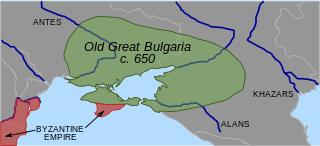
Old Great Bulgaria, also often known by the Latin names Magna Bulgaria and Patria Onoguria, was a 7th-century Turkic nomadic empire formed by the Onogur-Bulgars on the western Pontic–Caspian steppe. Great Bulgaria was originally centered between the Dniester and lower Volga.
The history of Christianity in Hungary started in the Roman province of Pannonia, centuries before the arrival of the Magyars, or Hungarians.

The Avar Wars were fought between Francia and the Avar Khaganate in Central Europe from 788 to 803, and ended with the Frankish conquest of the khaganate's western regions. The first conflicts between the Avars and the Franks occurred in the 560s, shortly before the Avar conquest of the Pannonian Basin. Armed conflicts between the two powers were not unusual during the following centuries.
